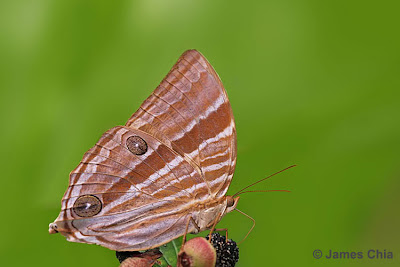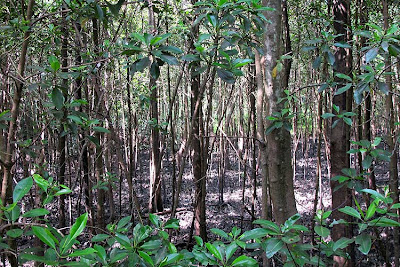Butterfly Photography at Our Local Parks
Featuring : Pasir Ris Park
Pasir Ris Park (白沙公园) occupies an area of about 71 hectares and is situated at the north-eastern part of Singapore island. The park stretches from Pasir Ris Road to Jalan Loyang Besar. The park can be accessed through Elias Road and Pasir Ris Green. The park is cut into three sections by the Sungei Api Api and Sungei Tampines rivers. The term Pasir Ris is Malay for 'beach bolt-rope', implying a narrow beach.
A distinguishing feature of this park is the carefully conserved 6-ha mangrove forest, where the mangrove habitat was maintained by retaining daily tidal inundation of the mudflats via Sg Tampines. The conserved intertidal habitat features a good biodiversity of flora and fauna.
The main area of interest for butterfly watching can be accessed via Pasir Ris Green which is a short walk from the Pasir Ris MRT Station, or if you drive, you may park at Carpark C. The good news is that parking is free!
 |
Members of the Green Volunteer Network & ButterflyCircle |
Trails for cycling and pedestrians are clearly marked. For the butterfly watcher, the first port of call would be at the Kitchen Garden. This garden, maintained by volunteers. The main 'custodians' of the garden are the members of the Green Volunteers Network (GVN), led by the energetic, inspirational and indomitable Grant Pereira.
 |
The indomitable Mr Green - Grant Pereira |
The butterfly garden in this area, carefully tended by Grant and his members by planting many butterfly host and nectaring plants, have attracted quite a number of species of butterflies.
On a warm sunny morning, one can expect to see at least 10 or more species fluttering amongst the flowers and shrubbery, and female butterflies ovipositing on the various host plants at the butterfly garden.
There is a plan by the National Parks Board to expand this free-ranging butterfly garden to at least three times its present size, and the GVN is looking forward enthusiastically to make the new garden a success.
 |
Crows feeding on the flowers of Syzygium |
Along the main trails, do look out for a number of Syzygium trees that flower seasonally. When in full flower, these trees attract quite a number of butterflies - primarily from the Danainae and Lycaeninae subfamilies, and features a butterfly "buffet" for the enthusiast. When feeding, these butterflies are more docile and make good photographic subjects.
At the fringe of the mangrove area, large bushes of Ixora, usually in full bloom, attracts various species of butterflies like the Common Mormon, Common Mime, Common Palmfly and a variety of Lycaeninae and Hesperiidae species. The Ixora is also a known host plant to the Common Tit, whose caterpillars live in symbiosis with the aggressive Kerengga ants. Indeed, as one negotiates amongst the bushes looking for butterflies, do beware of these ants that are always ready to take a bite out of any intruder into their territory!
Access into the mangrove area is via the boardwalks. These boardwalks, slightly elevated above the muddy brackish-water grounds, have been constructed to give convenient access to visitors so that they do not have to get their feet (or shoes) wet and muddy!
 |
The eco-friendly concrete planks look like real wood! |
An interesting fact about the boardwalks that is not commonly known, is that the "planks" are actually manufactured out of concrete and strengthened by glassfibre. They are set in a mould that makes the planks appear like thick wooden boards. This makes the boardwalk material more environmentally friendly and also more durable. Imagine the number of trees that would have to be cut down, if the boardwalk planks are made of real wood!
 |
Cerbera odollam (Pong-Pong) - host plant to the King Crow |
In the mangrove area, are plants that sustain a few key species of butterflies. The main one is the Pong-Pong tree (Cerbera odollam), the caterpillar host plant of the very local and moderately rare King Crow (Euploea phaenareta castelnaui). The largest member of its genus Euploea and also the largest Danainae species, the King Crow is a regular resident at Pasir Ris, where it is most often seen regularly.
Some of the Palmae like the Fishtail Palm (Caryota mitis) is also host plant to several species of Hesperiidae that can be found in the shady patches of forests in the mangrove area. Species like the Chequered Lancer, Common Redeye, Full Stop Swift, Common Awl and Sumantran Sunbeam are frequently found in the mangrove area.
Occasionally, the larger and more showy species like the Palm King, Blue Nawab and the Knight make appearances within the mangrove area, particularly when the Melastoma bushes are fruiting.
The mangrove environment is also an interesting destination for the nature enthusiast, as one can see the other creatures in the special habitat.
If one observes quietly, there will be surprises like crabs, mud lobsters, mud skippers and a variety of other insects in the area. Moths are also frequently seen, in particular the spectacular Atlas Moth.
The signage along the network of boardwalks features good information and anecdotes about the denizens of this private habitat. The informal cartoon sketches and simple language used would appeal to nature enthusiasts of all ages and walks of life. Shelters and other amenities along the boardwalk make for good resting places after a good walk around the hot and humid mangrove environment.
On a good day, a butterfly watcher can easily spot 15-20 species in this small area of Pasir Ris Park from the Kitchen/Herb & Spice Garden to the Mangrove forest area. The park is easily accessible and is clean and safe. Whilst many of the more urban and common species can be seen here, the unique mangrove habitat also makes this park a place where the King Crow is more regularly spotted than at any other location in Singapore.
The park itself is popular with residents staying on the eastern sector of Singapore. Cyclists, joggers, rollerbladers, exercise enthusiasts, nature lovers, picnickers and people just out for some fresh air and sunshine frequent this park regularly.
For the butterfly watcher it is a location where you can spend a couple of hours or a whole morning at a relatively urban location, but where you can also see some rarities amongst our winged jewels of Singapore!
Text by Khew SK : Photos by James Chia, James Foong, Khew SK, Loke PF & Benedict Tay
More information about Pasir Ris Park
- NParks website - Pasir Ris Park
- Places of Interest in Singapore - Pasir Ris Park


































